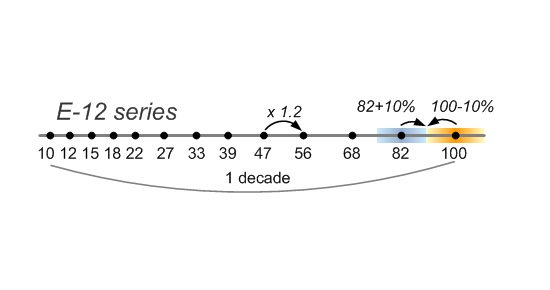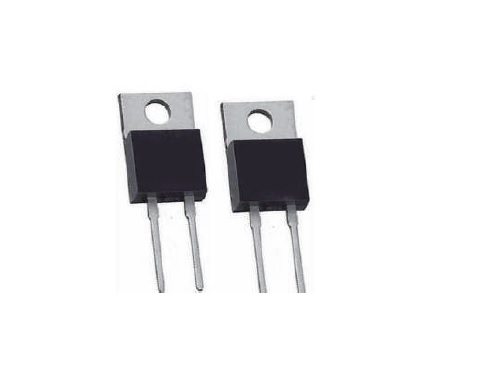Position:Home » Technical Articles
Standard Resistor Values E12
Writer:Microhm Page View:Date:2019-12-02
In 1952 the IEC (International Electrotechnical Commission) decided to define the resistance and tolerance values into a norm, to ease the mass manufacturing of resistors. These are referred to as preferred values or E-series, and they are published in standard IEC 60063:1963. These standard values are also valid for other components like capacitors, inductors and Zener diodes. The preferred values for resistors were established in 1952, but the concept of the geometric series was already introduced by army engineer Renard in the 1870s. Microhm Electronics also follow these standards and rules for resistors.
The standardization of resistor values serves several important purposes. When manufacturers produce resistors with different resistance values, these end up approximately equally spaced on a logarithmic scale. This helps the supplier to limit the number of different values that have to be produced or kept in stock. By using standard values, resistors of different manufacturers are compatible for the same design, which is favorable for the electrical engineer.
 Aside from the preferred values, many other standards related to resistors exist. An example is standard sizes for resistors, or the marking of resistors with color codes or numerical codes. Power ratings of resistors are not defined in a norm, therefore often is deviated from the above described series.
Aside from the preferred values, many other standards related to resistors exist. An example is standard sizes for resistors, or the marking of resistors with color codes or numerical codes. Power ratings of resistors are not defined in a norm, therefore often is deviated from the above described series.
As basis the E12 has been developed. E12 means that every decade (0.1-1, 1-10, 10-100 etc) is divided in 12 steps. The size of every step is equal to: Formula for preferred values for resistors 10^(1/12)=1.21
One could also say every value is 21% or 1.21 times higher than the last, rounded to whole numbers. Because of this, all resistors with a tolerance of 10% overlap. The series looks as follows: 1– 1.2 – 1.5 – 1.8 – 2.2 – 2.7 – 3.3 – 3.9 – 4.7 – 5.6 – 6.8 – 8.2 – 10 etc. All these values can be powers of ten (1.2– 12 – 120 etc).
Next to the E12 series, other series are existing. It is a good practise to specify resistors from a low series when tolerance requirements are not high. The most common series are:

E6 20%
E12 10%
E24 5% (also available with 1%)
E48 2%
E96 1%
E192 0.5% (also used for resistors with 0.25% and 0.1%).
Microhm Electronics' NLR series follow E6, E12 and E24 standards according to different resistance range. LMK series follow E24 and E96 standards.
The standardization of resistor values serves several important purposes. When manufacturers produce resistors with different resistance values, these end up approximately equally spaced on a logarithmic scale. This helps the supplier to limit the number of different values that have to be produced or kept in stock. By using standard values, resistors of different manufacturers are compatible for the same design, which is favorable for the electrical engineer.

As basis the E12 has been developed. E12 means that every decade (0.1-1, 1-10, 10-100 etc) is divided in 12 steps. The size of every step is equal to: Formula for preferred values for resistors 10^(1/12)=1.21
One could also say every value is 21% or 1.21 times higher than the last, rounded to whole numbers. Because of this, all resistors with a tolerance of 10% overlap. The series looks as follows: 1– 1.2 – 1.5 – 1.8 – 2.2 – 2.7 – 3.3 – 3.9 – 4.7 – 5.6 – 6.8 – 8.2 – 10 etc. All these values can be powers of ten (1.2– 12 – 120 etc).
Next to the E12 series, other series are existing. It is a good practise to specify resistors from a low series when tolerance requirements are not high. The most common series are:

E6 20%
E12 10%
E24 5% (also available with 1%)
E48 2%
E96 1%
E192 0.5% (also used for resistors with 0.25% and 0.1%).
Microhm Electronics' NLR series follow E6, E12 and E24 standards according to different resistance range. LMK series follow E24 and E96 standards.
Keywords:E12
Latest News
- Resistor's role in measuring and correcting LED,,,
- Single through-hole resistors' characteristics ,,,
- Why shunt resistors for current sense applicati,,,
- Metal-film resistors with small size, high resi,,,
- 36W High-Current Shunt Resistors MMS8420,,,
- 1W Surface Mount Resistor MPR1206,,,
- An Overview of Microhm Electronics' Resistor Pr,,,
- More anti-sulfur resistors used in harsh envir,,,
- Resistance changes with temperature,,,
- 140W TO247 High Power Heatsinkable Resistor,,,
- MMS5930 is ideal for current sensing in industr,,,
- Shunt resistors selection for engineers' design,,,
- Considerations for choosing precision resistors,,,
- Ceramic Encased Cement Resistors NWH Series for,,,
- Resistors for Passive Balancing in Battery-Pow,,,
Hot Articles
- Microhm will take part in 10th Automotive World,,,
- Thanks for Visiting Microhm's Booth E5-5706 in ,,,
- Resistors in Short Supply: Blame Cars,,,
- New lunch: High Power Precision Shunt Resistor,,,,
- How to Test a Resistor,,,
- Innovative Technology, Future Electric: Electri,,,
- What is Precision Resistors?,,,
- SMD Resistors Sizes and Packages,,,
- The Construction and Features of Metal Film Res,,,
- What is a TO-220 Resisor?,,,
- Hot Selling Products: Precision Shunt Resistors,,,
- How to Calculate the Equivalent Resistance Valu,,,
- What is a Fixed Resistor?,,,
- Resistors in LED Circuits,,,
- Resistors Types and Materials Overview,,,
Resistance applications
- Carbon Film Resistors' Features and Application,,,
- The Four Important Functions of Alloy Resistors,,,
- Difference Between High Precision Resistors and,,,
- Select the Right Resistor for Harmonic Filterin,,,
- Surface Mount Resistor's Size and Package ,,,
- The Measurement Accuracy of Automotive Shunt is,,,
- Industrial Roberts Applied to Solar Photovoltai,,,
- Precision Resistors' Construction and TCR,,,
- Heater Blower Motor Resistor in Air Conditioner,,,
- Why Zero-Ohm Resistors?,,,
- The Main Application for High Precision and Low,,,
- Urbanization Development Bringing the Transform,,,
- BMS for New Energy Vehicle,,,
- Shunt Resistor MMS8420 for High Current Stable ,,,
- Miniature future for passive electronic compone,,,
